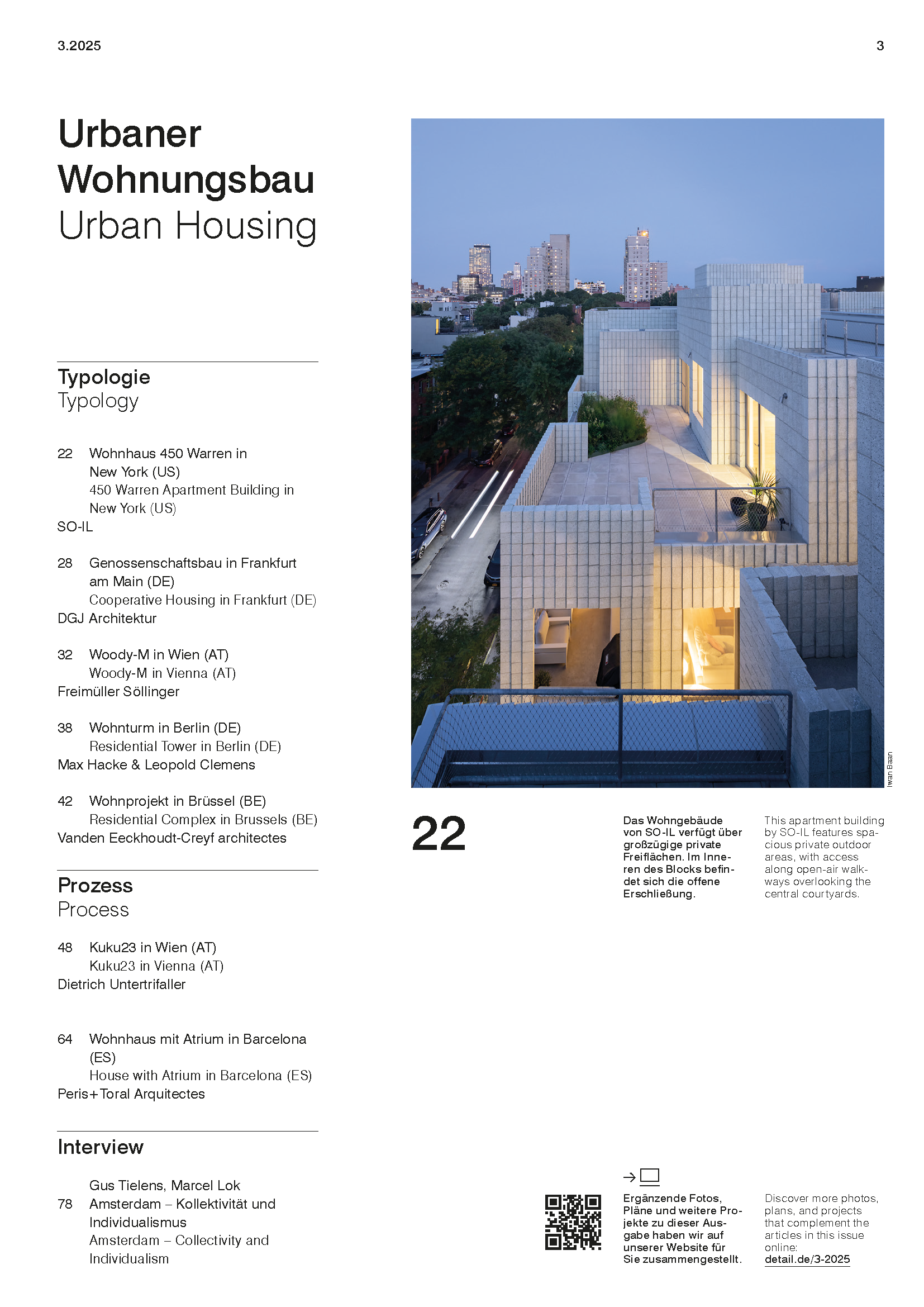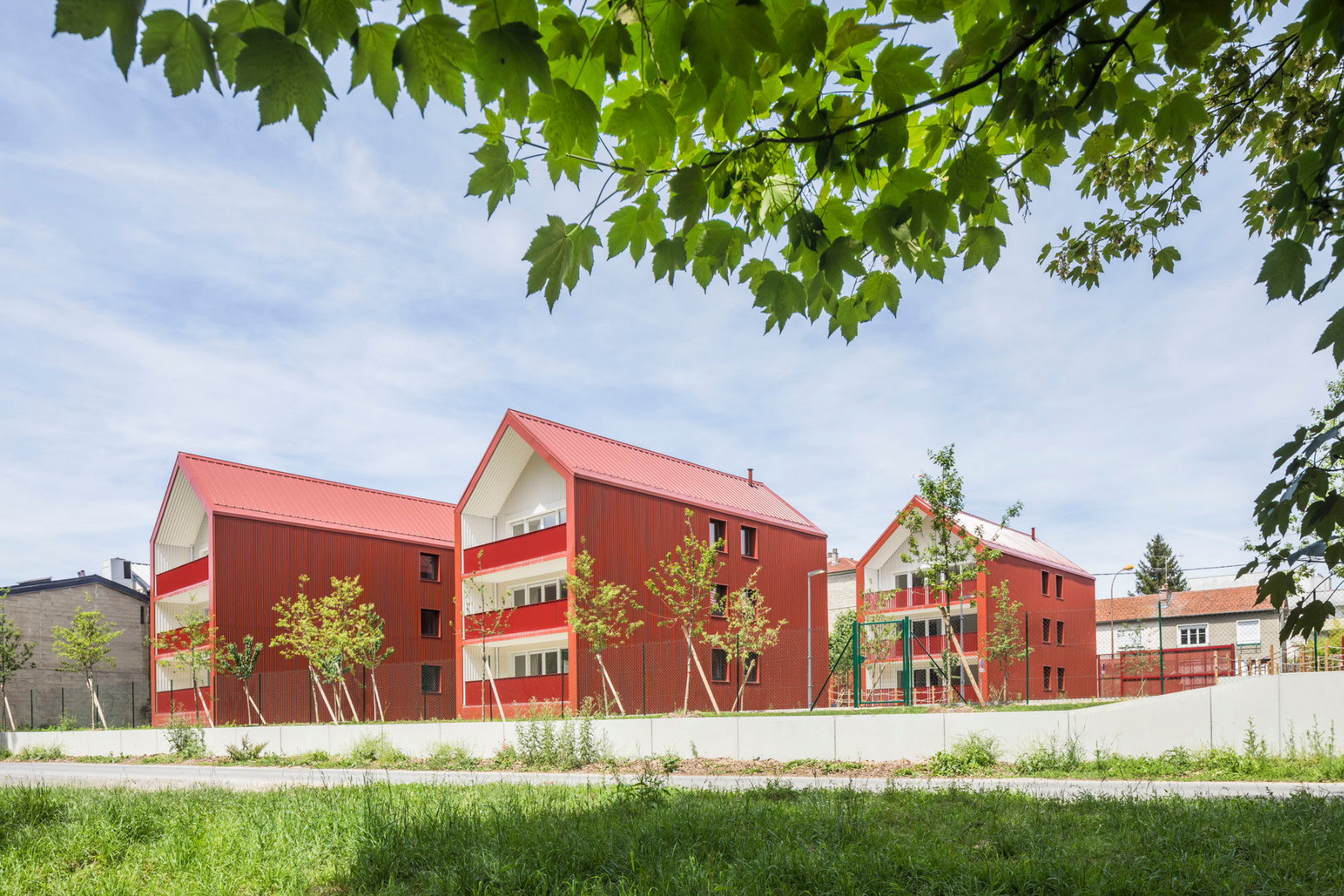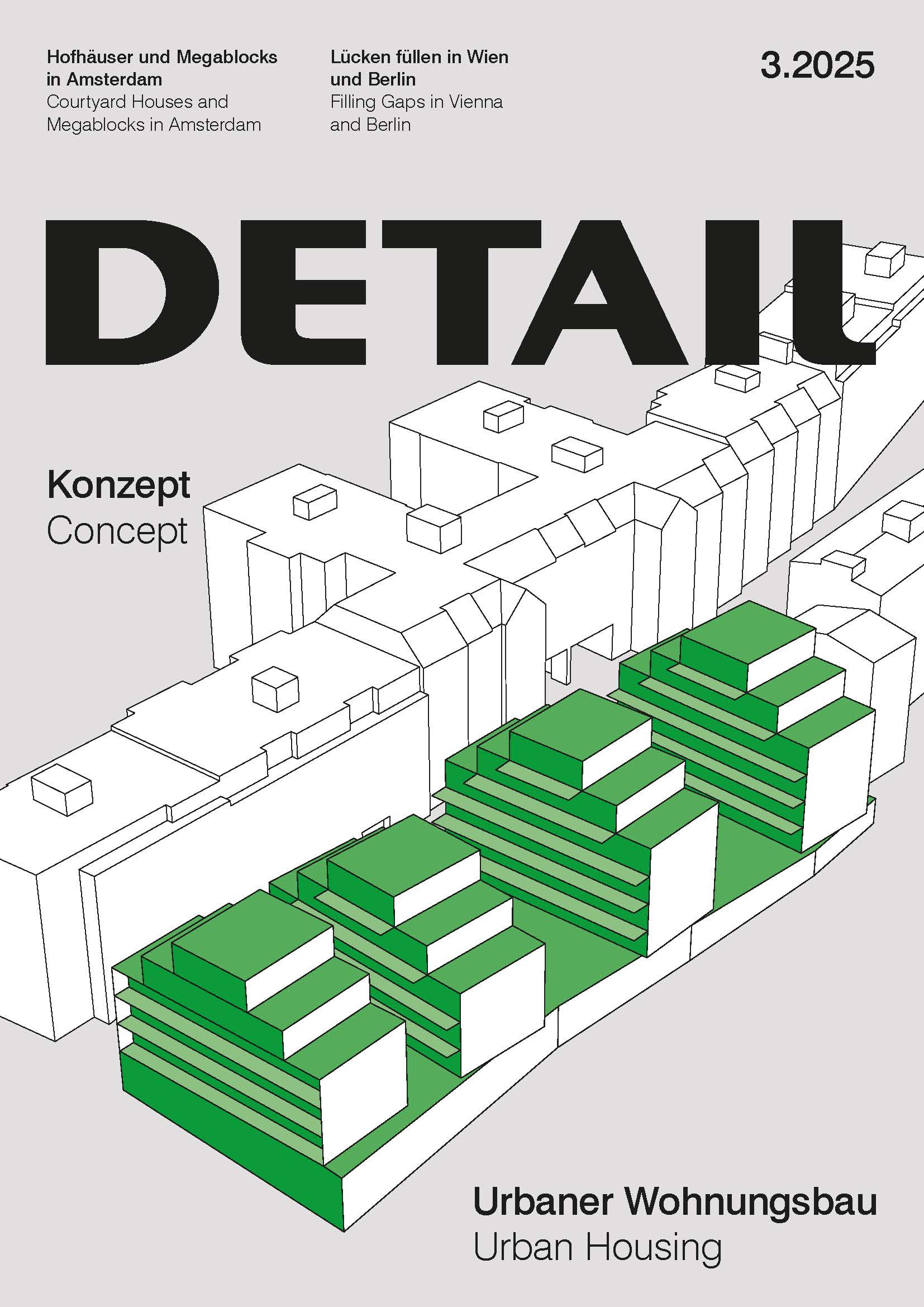Mixed, Compact, Affordable, Liveable
Building plots are becoming scarce, housing costs are soaring, and apartments in new developments are shrinking. Properties long considered unsuitable or uneconomical for building are now being developed, and residential units are increasingly stacked – side by side and on top of each other – into ever-larger blocks. Standardisation and industrial prefabrication seem indespensible – is this an echo of the 1970s?
Today, unlike the car-oriented satellite towns of postwar modernism, there is a renewed commitment to the European pedestrian city. The model has shifted from suburban houses to urban living. This means mixed housing arrangements with communal spaces for social interaction, and high-quality, functional, affordable apartments within compact footprints – sometimes with integrated art studios. Ground-floor zones – hosting cultural centres, supermarkets, coworking spaces, kindergartens, or changing rooms for a nearby school’s sports field – foster neighbourhood cohesion, reduce travel distances, and advance car-free cities. Above all, communal spaces and integrated facilities make compact living more bearable – much like corner pubs or coffee houses served as informal living rooms in early 20th century metropolises.
For this issue, Sabine Drey and I explored outstanding housing projects in Amsterdam, Barcelona, Brooklyn, Brussels, Frankfurt, and Vienna, showcasing innovative responses to urban challenges. Modern buildings, even those meeting today’s energy standards, still need to prove their long-term viability against their concrete counterparts from the 1970s. Housing developments like Alt-Erlaa in Vienna or the Olympic Village in Munich have thrived for half a century and remain as popular now as they were when they were completed. Frank Kaltenbach




Increasing Density
Projects in this Issue
-

Social sustainability
Kuku23 in Vienna – Living in a Cultural Centre
Dietrich Untertrifaller, art:phalanx and Reality Lab bring art and culture to the new neighbourhood. This creates a sense of community among the residents and with their neighbours.
-

Circular building
Co-Operative Building in Frankfurt am Main by DGJ
A colourful glass facade wraps around DGJ Architektur's cooperative housing near Frankfurt city centre. It serves as an eye-catcher and an effective soundproofing facade for the day-care centre and the residents.
-

Subsequent densification in solid wood
Woody M Apartment Block in Vienna
In Vienna's Meidling district, Freimüller Söllinger has created 85 flats in solid timber construction on a former supermarket site.
Vorherige Ausgaben
Further Contributions on the Topic
-

DETAIL Award 2024
Conversion of a Warehouse into a Residential Building
The nominees for the Detail Award 2024 have been announced: The former Coop wine warehouse in Basel’s Lysbüchel neighbourhood was transformed into a multistorey residential building, designed to accommodate residents of all ages and diverse lifestyles.
-

DETAIL Award 2024
Non-Hierarchical Social Housing
The nominees for the Detail Award 2024 have been announced: Barcelona-based architectural duo Peris + Toral has realised 43 flats made of clay on Ibiza, setting new standards in social housing construction.
-

Sustainable living in wood
Apartment House in Berlin by Scharabi Architekten
Sustainable building techniques, social cohesion and a great degree of comfort come together at Holzhaus Linse [Engl.: Linse wooden house] in Berlin’s Schöneberg district. This creative living concept is a test for the metropolitan lifestyles of the future.
-

Living in community
ParkLife: The Carbon-Neutral Residential Building in Melbourne
This community-focused, cost-optimized residential block of 37 flats is Australia’s most sustainable apartment building.
-

Urban outside, green within
Social Housing in Groningen by De Zwarte Hond
The Regulateur residential project is Janus-faced: towards the city, it shows brickwork and regularly perforated facades. The apartments open onto the courtyard, from which they are accessed as well.
-

A touch of colour on the arterial road
Residential District in Champagne by Philippe Gibert
Archetypal shapes and gleaming colours characterize Philippe Gibert’s design for six multifamily buildings featuring social housing in the eastern French city of Châlons-en-Champagne.
Vorherige Ausgaben
Previous Issues
-

Digital and Sustainable 1-2.2025
What lies ahead for architecture in the digital age? To gain insight, we surveyed architects from around the globe on the role of artificial intelligence. The result is a fascinating snapshot of their perspectives.
-

Masonry 12.2024
In addition to the winning projects of the Detail Award, our December issue takes us to masonry buildings in France and southern England and to Danish brick construction.
-

Timber Construction + Prefabrication 11.2024
From residential estates and office complexes to an observation tower and an Olympic milestone in Paris, this issue showcases the versatility of timber construction through seven exemplary projects.
-

Building Envelopes 10.2024
While many new residential buildings are generic investor projects using cheap materials, Paris continues to lead with experimental milestones in the use of natural building materials. We present these building envelopes in this issue.
-

New Work 9.2024
New Work is a widely used term these days, but its meaning often remains unclear. In this concept edition of Detail, we let current projects illustrate these changes rather than providing rigid definitions.
-

Building in the Mountains 7/8.2024
From the metropolis to the solitude of the mountains: In our summer issue, we explore two highly contrasting subjects. The Olympic Games in Paris and Building in the Mountains.
-

Climate and Resources 6.2024
Sustainability encompasses various practices, all aimed at reducing carbon emissions. With this June issue, we spotlight six diverse projects that are taking steps towards a climate-neutral future in very different ways.
-

New Housing in Old Stock 5.2024
The focus should be on developing housing within existing buildings and settlementstructures – through conversions, additions, extensions, and densification. Our new issue illustrates how this can be achieved.
-

Balconies, Loggias, Terraces 4.2024
Out into the open! Our April issue delves into the construction and design of buildings with balconies, terraces, loggias, and arcades. We hope you enjoy exploring these features.
-

Schools 3.2024
Is it possible to reduce costs and guarantee quality simultaneously in construction? As we embark on the new year, we confront a pressing issue that will accompany us for some time to come.
-

Simple + Cost-Efficient 1/2.2024
Is it possible to reduce costs and guarantee quality simultaneously in construction? As we embark on the new year, we confront a pressing issue that will accompany us for some time to come.
-

Increasing Density 12.2023
This December issue is dedicated to urban density and the architectural solutions needed to achieve it. While we understand the necessity of densification, few are eager to sacrifice their own space.
-

Natural Building Materials 11.2023
In the last decade, timber construction has rapidly gained ground in the building industry. Our current issue documents multi-layered examples of the detailed application of natural building materials.
-

Windows and Facades 10.2023
Facades have always had many roles to play. They give buildings a face, protect them from the elements, and convey meaning. The examples presented in this issue highlight the merits of thoughtful facades.
-

Mixed Use 9.2023
We selected exciting projects for our September issue, focussing on mixed use concepts. They include residential and office spaces, sports halls and gastronomic functions and many more within their complex programs.
-

Saving Space 7/8.2023
Space is a type of resource we bring to light in this summer edition of Detail. Our Documentation section features innovative structures that make clever use of limited space.
-

Architecture and Climate Protection 6.2023
Anyone asking the inevitable question about climate protection in architecture today will receive not one but many answers.
-

Truth to Materials 4.2023
Debates about building materials in architecture inevitably mention the term “truth to materials” (known in German as “Materialgerechtigkeit”).
-

Hotels, Hostels, Guesthouses 3.2023
Few sectors of the economy were so battered during the corona years as the hotel industry.
-

Taking Stock 1/2.2023
Not only in Germany and Europe but also worldwide, building in existing structures is currently gaining in acceptance and relevance.
-

Building Envelopes 12.2022
While compiling our personal favourites of the year in the Detail editorial office, I was surprised at the vast scope of projects my colleagues had experienced in 2022. For this issue’s review of the year, they describe their architectural observations in places like Jerusalem, Berlin, and Montagnana, Italy.
-

Circular Economy 11.2022
If the aim is net zero, demolition and landfill disposal must be avoided at all costs. Today, a progressive architecture is one that takes part in the circular economy and reuses building materials.
-

Lighting Interiors 10.2022
Our October issue is all about light and interiors. PPAG’s school in Vienna brings daylight into deep cluster spaces to foster daily well-being.
-

Cultural Buildings 9.2022
In 1997, the Guggenheim Museum opened in Bilbao, and Frank Gehry’s eccentric new building transformed the Basque city into an overnight hotspot for international tourism.
-

Urban Green 7/8.2022
Especially in big dense cities, roofs and facades are the only places left to make things greener.
-

Simple and Affordable 6.2022
“Doing away with everything superfluous creates the potential for an architectural quality all of its own,” says Florian Nagler about “simple building” in an interview with Frank Kaltenbach.
-

Prefabrication Modular Construction 5.2022
Naturstein und Hochlochziegel, Ortbeton und Stampflehm in vorproduzierten Elementen: Für die Massivbauweise kommen viele unterschiedliche Materialien in Frage, und oft ist ihre Anwendung regional motiviert.
-

Solid Construction 4.2022
Natural stone and perforated bricks, cast-in-place concrete, and rammed earth in prefabricated elements – these are just a few of the diverse materials used in solid construction, and their use is often regionally motivated.
-

Urban Housing 3.2022
“A villa in the countryside with a large terrace, in front of you the Baltic Sea, Friedrichstrasse behind you …”. Thus begins Kurt Tucholsky’s 1927 poem, “The Ideal”. While Tucholsky’s ideal of urban life might be unattainable in Berlin, there are cities where it has become a reality.




